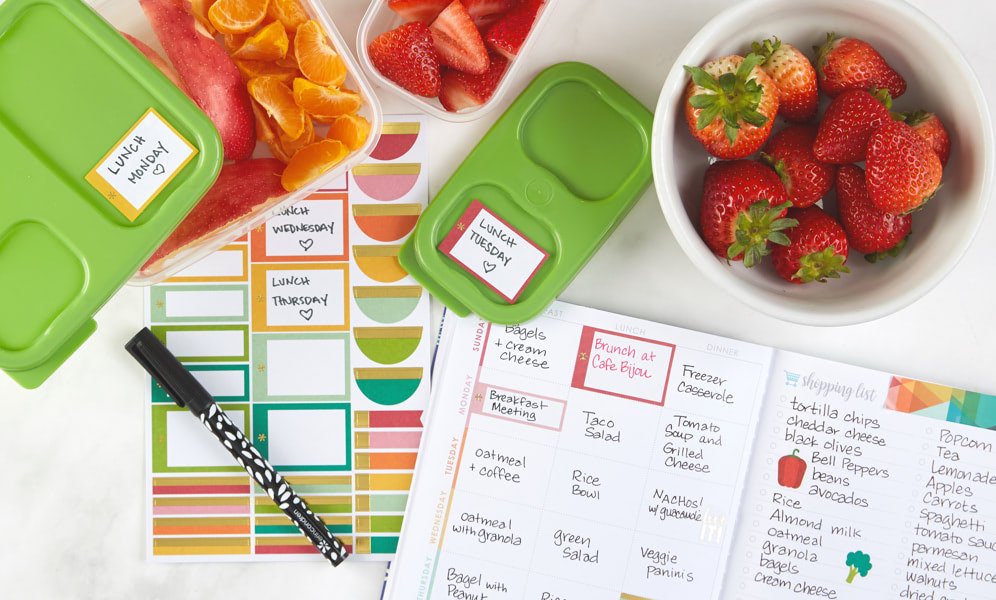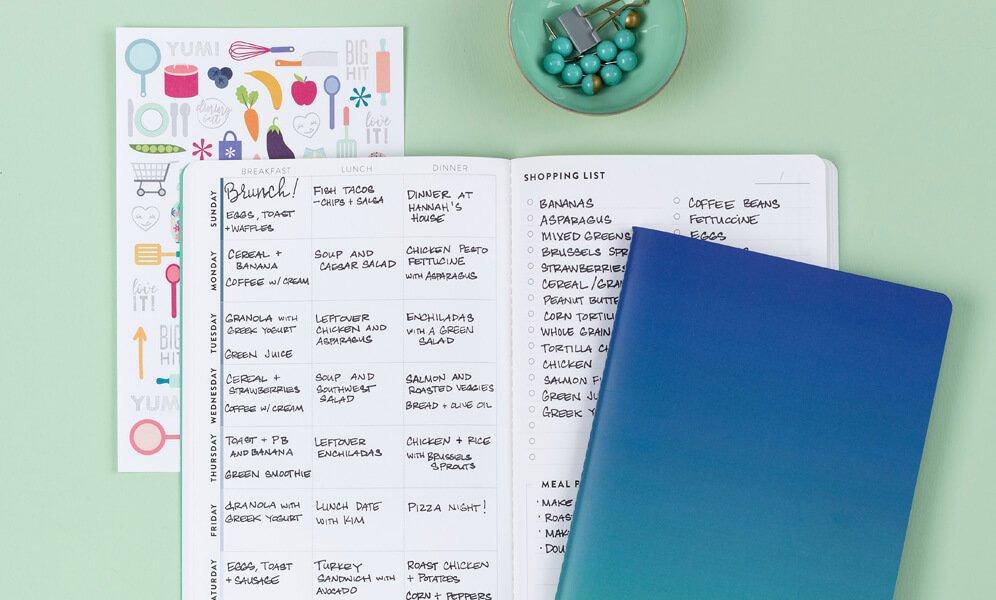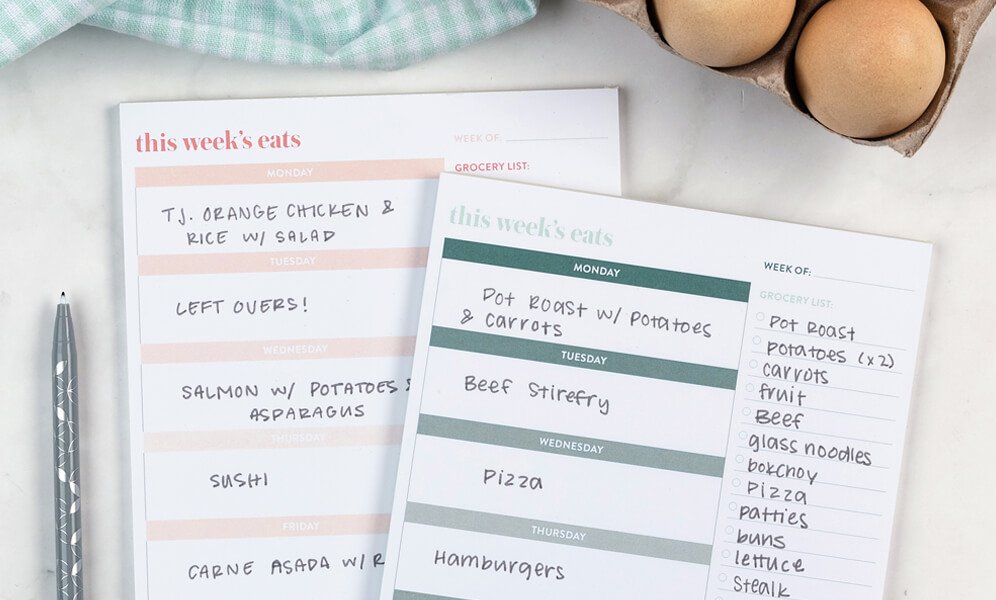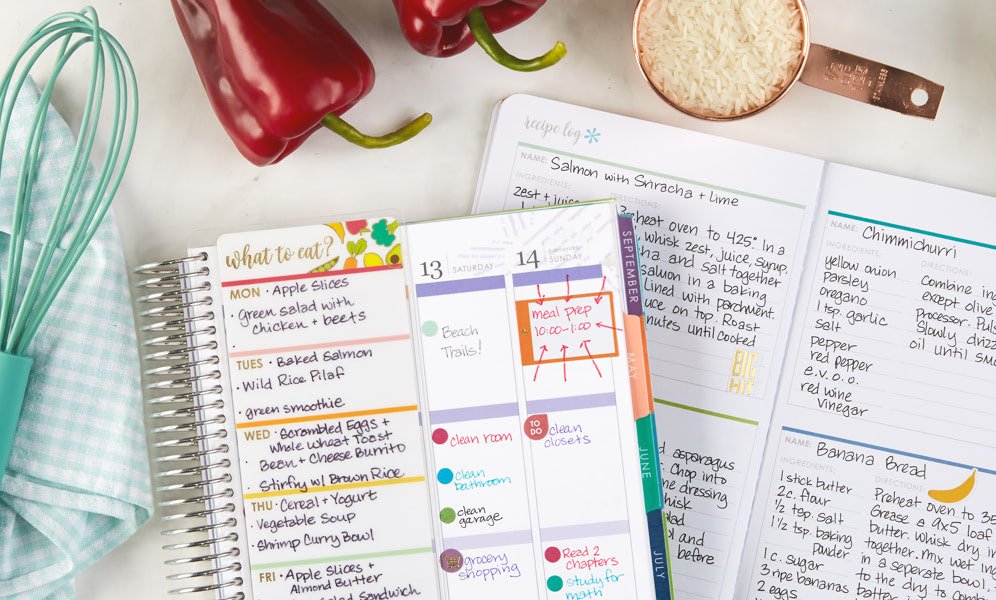Meal Planning Tips: How to Meal Plan for Beginners

Meal planning is a great way to take control of your diet and save time and money (and these days, that can also relieve a lot of stress). By planning your meals in advance, you can avoid the anxiety of figuring out what to eat each day and make sure that you are eating a balanced diet.
Don't worry if you're a beginner! Below, we'll cover everything you need to know, including what meal planning is, why you should do it, different meal planning styles, helpful tools, and step-by-step instructions on how to meal plan. Then, we'll wrap it up with some fun tips for meal planning success!
What Is Meal Planning?
Meal planning is the act of deciding what you will eat for your meals in advance. It involves taking into consideration your schedule, dietary needs, and preferences, and creating a plan for your meals for a certain period. It can be a weekly, bi-weekly, or monthly plan. Meal planning can also include the preparation of meals ahead of time, such as cooking and freezing meals for later use.
Why Meal Plan?
There are several benefits to meal planning. First, it can save you time and money. By planning ahead, you can make fewer trips to the grocery store and buy only what you need, which can save you money. Additionally, by knowing what you will eat ahead of time, you can save time on meal preparation.
Second, meal planning can help you eat healthier. When you plan your meals, you can ensure that you are eating a balanced diet and meeting your nutritional needs. You can also avoid unhealthy impulse purchases at the grocery store or fast food restaurants.
Finally, meal planning can reduce stress. When you have a plan in place for what you will eat, you can eliminate the stress of having to figure out what to make for dinner each night.
Meal Planning Styles
There are several meal planning styles to choose from, depending on your preferences, lifestyle, and weekly schedule.
- Batch Cooking: Batch cooking involves cooking a large quantity of food at once, then portioning it out for later use. This is a great option for busy individuals who don’t have a lot of time to cook during the week.
- Theme Nights: Theme nights involve planning your dinner around a certain theme, such as Mexican Night, Italian Night, or Meatless Monday.
- Meal Kit Delivery: Meal kit delivery services provide pre-portioned ingredients and healthy recipes for you to prepare at home. This is a great option for those who want to save time on meal planning and grocery shopping.
- Freezer Meals: Freezer meals involve preparing breakfast, lunch, and/or dinner ahead of time and freezing them for later use. This is a great option for busy individuals who want to save time on meal preparation.
Meal Planning Tools

From digital and paper planners to guided notepads to creating your own meal plan in a blank notebook, there are several tools available to help you meal plan by day, week, and beyond.
- Meal Planning Apps: Meal planning apps, such as Mealime or Paprika, can help you plan your meals, create a shopping list, and track your food inventory.
- Cookbooks: Cookbooks provide a wealth of breakfast, lunch, and dinner ideas and new recipes to choose from.
- Online Recipes: Websites such as Pinterest, Allrecipes, or Food Network provide a vast collection of recipes to choose from.
- Whiteboard, Chalkboard, or Weekly Wall Calendar: A whiteboard, chalkboard, or weekly wall calendar in your kitchen can serve as a visual reminder of your meal plan for the week.
- Meal Planner Book: If you prefer a tangible option for meal planning, a meal planner book or meal planning notepad can be a great tool to help you organize, food prep, plan meals, and eat healthy food while saving time every day.
- Grocery List Notepad: In addition to meal planner books and apps, a grocery list notepad can also be a useful meal planning tool. These notepads typically have pre-printed categories, such as produce, dairy, meat, and pantry items, to help you easily organize your grocery list. Some notepads even come with tear-off sheets and magnetic backing, making it easy to take your grocery list with you to the store.
- Monthly Planner: Using a customizable monthly planner can help you plan your meals in advance for the entire month, which can save you time and reduce stress. It can also help you stay on track with your health and wellness goals and avoid unhealthy impulse purchases.
- LifePlanner™: For those who love to get creative and personalize their meal planning process, creating your own meal planning chart in a LifePlanner™ can be a fun and unique meal planning tool. LifePlanners are customizable planners that allow you to choose the cover design, layout, and add-ons to suit your preferences.
- Notebook or Bullet Journal: You can also use a simple, blank notebook or bullet journal to create your own meal plan. This option allows you to use any notebook or journal you have on hand and customize it to fit your unique style.
Learn more about How to Start Planning.
How to Meal Plan Step-by-Step

Now that you know why meal planning is beneficial and the different meal planning styles and tools available, here are some step-by-step instructions on how to meal plan.
Set aside time to plan.
Choose a day and time each week to sit down and plan your meals for the upcoming week. This could be a Sunday afternoon or a Thursday evening, depending on your schedule.
Inventory your fridge, freezer, and pantry.
Before you start meal planning, take inventory of the items you already have in your fridge, freezer, and pantry. This will help you avoid buying unnecessary items and make the most of what you already have.
Decide what you want to cook.
Once you know what ingredients you have on hand, decide what you want to cook for the week. You can choose to plan out all of your meals or just a few, depending on your preferences. When deciding what to cook, take into consideration your schedule for the week. If you have a busy schedule, plan for a quick and easy meal. If you have more time, plan for a more elaborate meal.
Make your grocery list and shop.
After you’ve decided what you want to cook, make a grocery list of the items you need to buy. Be sure to check your inventory first to avoid buying duplicates. When you go grocery shopping, stick to your list and avoid buying items that are not on your list. This will help you stay within your budget and avoid food waste.
Meal prep.
Meal prep involves preparing your meals ahead of time. This can include chopping vegetables, cooking meat, or making sauces. By doing some of the prep work ahead of time, you can save time during the week, cut down on food waste, and make meal preparation easier.
Meal Planning Tips for Success

Here are some tips to help you succeed with meal planning.
Set a budget.
Before you start meal planning, set a budget for your groceries. This will help you avoid overspending and make sure you are staying within your means.
Learn more about How to Set a Budget.
Follow your plan, but be flexible.
While it’s important to stick to your meal plan, don’t be afraid to make changes if needed. If you find that you have extra ingredients or leftovers, incorporate them into your meals instead of letting them go to waste.
Don’t forget to use your leftovers.
Leftovers can be a great way to save time and money on meal preparation. When planning your meals, consider incorporating leftovers into your plan.
Get the family involved.
Meal planning can be a great way to get the whole family involved in meal preparation. Consider letting each family member choose a meal for the week or helping with meal prep.
For more ways to get the family involved, check out Top 5 Family Organization Tips and Tools and Family Goal Setting Made Easy.
Think seasonally.
When planning your meals, consider using seasonal produce. Not only will this provide variety in your meals, but it can also save you money.
Meal planning is a great way to save time, money, and reduce stress. By taking inventory of your fridge, freezer, and pantry, deciding what to cook, making a grocery list and shopping, and doing some meal prep, you can create a plan for your meals that works for you. By following our meal planning tips, you can set yourself up for success and enjoy healthy, delicious meals every day. Remember, meal planning doesn't have to be complicated or time-consuming. Just start small and make adjustments as needed to find a system that works for you. With a little practice, you'll be a meal planning pro in no time.
Explore best-selling meal planning tools and get cooking!
Related Planning + Home Organization Guides
You may also enjoy these other tips, tricks, and guides for healthy, happy, organized living: